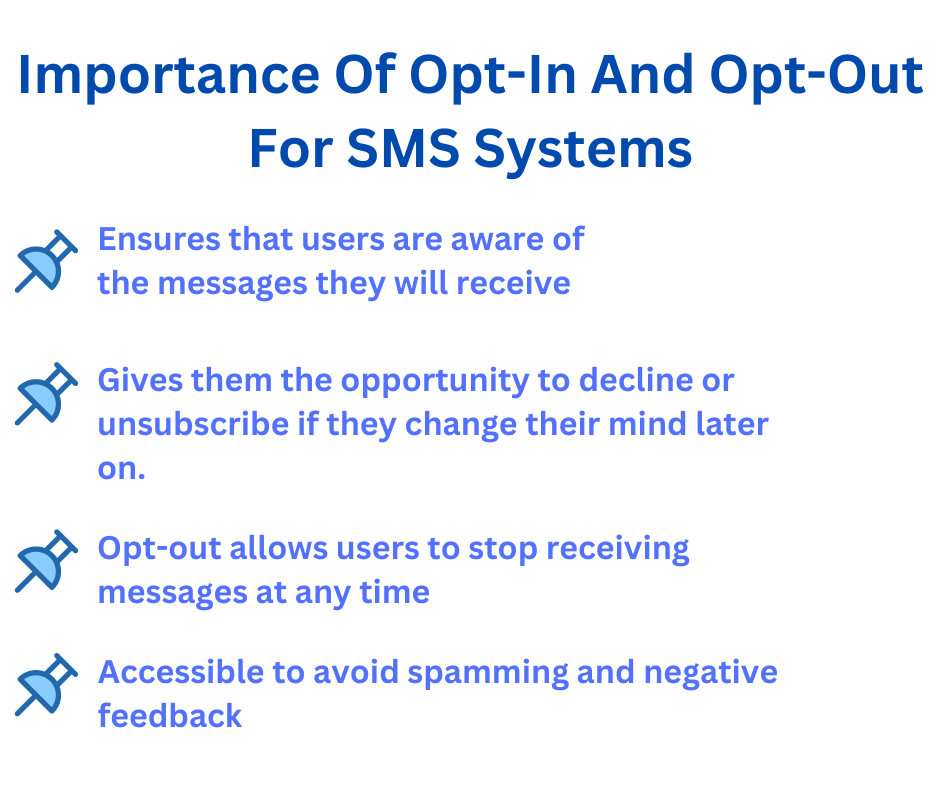What Are OPT-In And OPT-Out For SMS Systems?
SMS, or Short Message Service, is a communication platform that enables users to send and receive text messages through mobile devices. It is a widely used method of communication because of its simplicity and convenience.
SMS messages are limited to 160 characters but can be concatenated to form longer messages. SMS messages are sent through a cellular network, which means that both the sender and the recipient must have a mobile phone with a network connection.
SMS systems are used for a variety of purposes, including personal communication, marketing, and customer service. Businesses also use them to send alerts and notifications to customers and employees.
SMS is a reliable and secure communication platform that has become an integral part of modern life.
Opt-In for SMS Systems
Opt-in is a process that involves giving consent to receive messages or communications from a particular organization or service.
In the case of SMS systems, opt-in is the process of granting permission to receive text messages from an organization or company.
Opting-in for SMS systems usually involves sending a text message or filling out an online form with personal information such as name, phone number, and email address.
This information is then stored by the organization and used to send relevant and targeted text messages to the user.

The benefits of opt-in for users are numerous. One of the primary benefits is that users have control over the messages they receive and can choose to opt-out at any time.
Opt-in also ensures that users receive messages that are relevant to their interests and needs, making the information provided more valuable and useful.
Additionally, opt-in provides a layer of security and privacy for users, as it ensures that only authorized organizations have access to their personal information and can send them messages.
Opt-Out for SMS Systems
Opt-Out for SMS Systems is an important feature that allows users to have control over their messaging preferences. Opt-Out refers to the process of opting out of receiving further messages from a particular sender.
This feature is particularly useful for users who do not want to receive unsolicited messages or those who no longer wish to receive messages from a sender they previously subscribed to.
When a user chooses to opt out of a messaging list, they will no longer receive messages from the sender. This is usually done by sending a specific keyword or phrase as a reply to the message.

The SMS system will then remove the user from the messaging list and will no longer send messages to their phone number. This process is quick and easy and can be done at any time.
The benefits of Opt-Out for users include the ability to control the number of messages they receive, which can help reduce the number of unwanted messages that can be a nuisance.
This feature also helps to protect users from potential scams and other fraudulent activities that may occur through unsolicited messages.
Additionally, users who no longer wish to receive messages from a particular sender can easily Opt-Out without having to go through the hassle of contacting the sender directly.
Differences Between Opt-In And Opt-Out
Opt-in and opt-out are two different approaches to obtaining user consent for marketing communications, including SMS systems.
Opt-in requires users to actively give their permission to receive communication from a business, while opt-out assumes the user’s permission by default and gives them an option to unsubscribe later on.
When comparing opt-in and opt-out for SMS systems, there are several factors to consider, including user experience, compliance with regulations, and business objectives.
From a user perspective, opt-in is generally considered the better option since it gives users more control over their communication preferences.
By actively opting in, users are more likely to have a positive attitude toward the business and are more likely to engage with the communication they receive.
From a regulatory perspective, opt-in is often required by law to ensure that businesses are obtaining consent in a transparent and ethical manner.
Opt-out, on the other hand, can be seen as a grey area since it assumes that users are willing to receive communication unless they explicitly say otherwise.
From a business perspective, opt-out may seem more attractive since it allows for a larger audience to receive communication.
However, this approach can be counterproductive if users feel bombarded with unwanted communication, leading to negative brand perception and potential legal issues.
Ultimately, the choice between opt-in and opt-out will depend on the specific needs of the business and the preferences of their target audience.
Importance Of Opt-In And Opt-Out For SMS Systems
Opt-in and opt-out are two important features of SMS systems that allow users to control the messages they receive. Opt-in refers to the process of obtaining permission from a user before sending them any messages.
This can be done through various methods, such as filling out a form, sending a text message, or providing consent online.
Opt-in ensures that users are aware of the messages they will receive and gives them the opportunity to decline or unsubscribe if they change their mind later on.

On the other hand, opt-out allows users to stop receiving messages at any time. It is a simple and convenient way to unsubscribe from a service or campaign.
Opt-out can be done by replying to a message with a specific keyword or by following a link provided in the message. It is important for businesses and organizations to make opt-out easy and accessible to avoid spamming and negative feedback.

